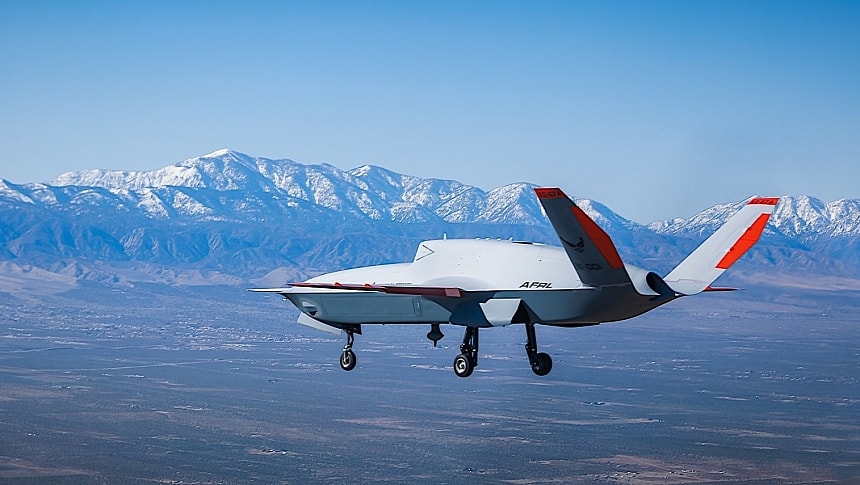Military drones are being made in large numbers now, and that means that somewhere on this Earth there are production lines for them. But the aircraft that rolls off these production lines, no matter their kind, are specialized at performing a specific task. That may change, as the U.S. is working on a common platform that can be adapted to serve more varied needs.
About a decade ago the American military kicked off an initiative called Low Cost Attritable Aircraft Technologies (LCAAT). It was an effort meant to come up with an aircraft production method called genus/species.
What that meant was the military was looking for a flying autonomous collaborative platform, the genus, from which a series of varied aircraft, the species, could be derived. As Doug Meador, autonomous collaborative platform capability lead with the Air Force Research Laboratory's (AFRL) Aerospace Systems Directorate said, it would be pretty much like in the automotive industry, where the same platform is often used to assemble different kinds of vehicles.
In the case of these drones, a common chassis could receive different aircraft kits, allowing for the rapid and less costly production of a specific machine.
The AFRL already tested such a design, the XQ-58A Valkyrie. Developed by defense contractor Kratos, the drone last flew in the summer of 2022, proving drones designed to support the operations of military aircraft the likes of the F-35 and F-22 fighter jets have merit.
At the end of February 2024, however, a so-called second generation of an autonomous collaborative platform stepped into the spotlight. It's called XQ-67A and it is made by General Atomics using the Valkyrie platform.
The exact specifications of this drone are not known, aside from the fact it is derived from the Valkyrie. In the standard configuration, the Kratos drone is capable of flying at speeds of 652 mph (1,050 kph) and reaching targets as much as 2,449 miles (3,941 km) miles away. It can carry weapons, in the form of Joint Direct Attack Munition (JDAM) and small-diameter bombs.
In XQ-67A clothes, "the first aircraft type built and flown using a common core chassis," the drone was flown in an Off-Board Sensing Station (OBSS) configuration, meaning with no weapons.
What OBSS means is that the platform could gather data that is not used by the drone itself but by the aircraft and other systems it is supposed to serve. A sort of remote touching arm, if you will, wirelessly attached to its body.
The test flight took place at the General Atomics Gray Butte Flight Operations Facility near Palmdale, California at the end of February, and it was deemed a success, even if we're not told exactly what that means.
The success of the flight is crucial, according to AFRL, as it now "paves the way for other aircraft species to be rapidly replicated on a standard genus chassis." And that, in a nutshell, means that the cost of making drones will decrease, and the speed of production will increase.
There is no mention from either of the parties involved on when a production version of these drones will make it into the open.
What that meant was the military was looking for a flying autonomous collaborative platform, the genus, from which a series of varied aircraft, the species, could be derived. As Doug Meador, autonomous collaborative platform capability lead with the Air Force Research Laboratory's (AFRL) Aerospace Systems Directorate said, it would be pretty much like in the automotive industry, where the same platform is often used to assemble different kinds of vehicles.
In the case of these drones, a common chassis could receive different aircraft kits, allowing for the rapid and less costly production of a specific machine.
The AFRL already tested such a design, the XQ-58A Valkyrie. Developed by defense contractor Kratos, the drone last flew in the summer of 2022, proving drones designed to support the operations of military aircraft the likes of the F-35 and F-22 fighter jets have merit.
At the end of February 2024, however, a so-called second generation of an autonomous collaborative platform stepped into the spotlight. It's called XQ-67A and it is made by General Atomics using the Valkyrie platform.
The exact specifications of this drone are not known, aside from the fact it is derived from the Valkyrie. In the standard configuration, the Kratos drone is capable of flying at speeds of 652 mph (1,050 kph) and reaching targets as much as 2,449 miles (3,941 km) miles away. It can carry weapons, in the form of Joint Direct Attack Munition (JDAM) and small-diameter bombs.
In XQ-67A clothes, "the first aircraft type built and flown using a common core chassis," the drone was flown in an Off-Board Sensing Station (OBSS) configuration, meaning with no weapons.
What OBSS means is that the platform could gather data that is not used by the drone itself but by the aircraft and other systems it is supposed to serve. A sort of remote touching arm, if you will, wirelessly attached to its body.
The test flight took place at the General Atomics Gray Butte Flight Operations Facility near Palmdale, California at the end of February, and it was deemed a success, even if we're not told exactly what that means.
The success of the flight is crucial, according to AFRL, as it now "paves the way for other aircraft species to be rapidly replicated on a standard genus chassis." And that, in a nutshell, means that the cost of making drones will decrease, and the speed of production will increase.
There is no mention from either of the parties involved on when a production version of these drones will make it into the open.






